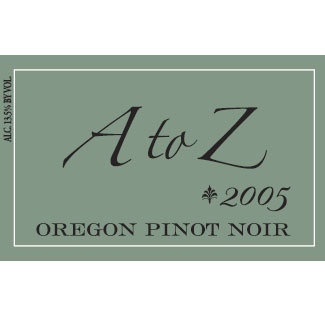 Pretty, garnet color. Warm Bing cherry, cranberry and sweet strawberry on the nose. On the palate, the wine has a slight silkiness, not too much, although that begs the question of how much is too much… Bright, cheerful acidity on the palate with some warm spice flavors that lingered in my mouth with a scrumptious Bing/black cherry finish. Very well balanced tannin and acidity. Yum-yum!
Pretty, garnet color. Warm Bing cherry, cranberry and sweet strawberry on the nose. On the palate, the wine has a slight silkiness, not too much, although that begs the question of how much is too much… Bright, cheerful acidity on the palate with some warm spice flavors that lingered in my mouth with a scrumptious Bing/black cherry finish. Very well balanced tannin and acidity. Yum-yum!
I am from Oregon, and I love Pinot Noir. And I love Oregon Pinot Noir, so it must be noted that I am biased in favor of this wine. Plus, their website is fancy-cool. One of the beefs I have with Oregon Pinot Noir is how expensive it tends to be, and A to Z really feels me on that one. Their whole gig is to bring good Oregon wine to my mouth without emptying my pocketbook on the way, and for that I thank them heartily. I don’t recall ever having an A to Z wine that I didn’t like, and I will try to remember to taste more of their stuff. You should be seeing more of their juice around your friendly local wine shop, as Wine Business Monthly named them the #1 Hot Small Brand of 2006.
A to Z Wineworks brought together a lot of very well-respected people in the Oregon wine industry with the aim to make a négociant-style wine in Oregon. This is a tradition quite common in France, especially in Burgundy (Jadot), Beaujolais (Duboeuf), and the Rhone Valley (Guigal and Jaboulet). A négociant can buy grapes or grape juice from vineyard owners and make it into wine, or she can buy wine fermented by the vineyard or even other wineries and blend that into a wine that she will then bottle under her own name. The most famous example of a négociant wine in the US is the infamous “Two-Buck Chuck,” or Charles Shaw, whose 2005 Chardonnay recently won the California State Fair’s prize for Best Chardonnay.
If you are horrified at the concept of drinking a wine that is a blend of juice from the Rogue Valley all the way up to Hood River, then you should carefully look for words like “estate bottled” on your wine label, because that’s about the only way you can tell that a US wine was really grown and pressed and fermented and bottled all by the same gal. Me, I care more about well-made, inexpensive, tasty tasty wine, so I don’t worry my head about that. A to Z’s 2005 Pinot Noir purportedly has about 40 different wines in its blend. If it produces an Oregonian Pinot Noir with some character and verve that I can afford to drink, I say, the more the merrier!
A caveat, in which the Scamp’s ass is covered: Not all négociants make great wine. Some of it is nasty plonk, not even worth that $6.99 you paid for it. But at the prices you’re likely to pay for these bottles, you can experiment with impunity.
Other US négociant labels include:
Castle Rock
Domaine La Due
Teira
Three Thieves
Stephen Vincent
Cloudline
Mark West
Stone Creek
The wines of Don Sebastiani & Sons are some of the most successful examples of California négociant wines. I list them separately here because I have learned that this company is financially and politically supportive of anti-choice legislation, and so I won’t be buying them or reviewing them here. Some of their wines include: Pepperwood Grove, Aquinas Napa Valley, Mia’s Playground, Screw Kappa Napa, Smoking Loon, Used Automobile Parts, Fusee, Gino Da Pinot, Le Bon Vin de La Napa Valley, Plungerhead, Hey Mambo, White Knight. Why they be harshing on the womens like that? Shame!
